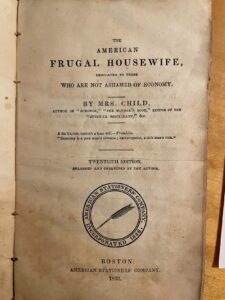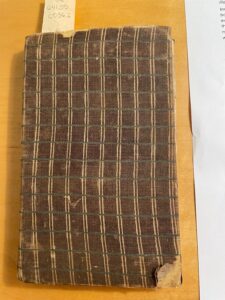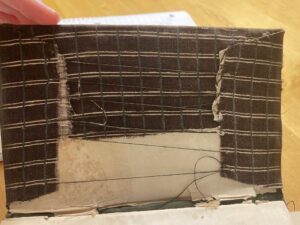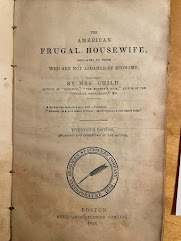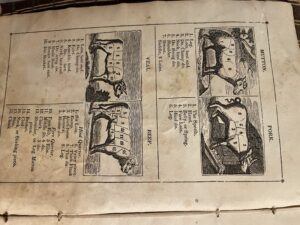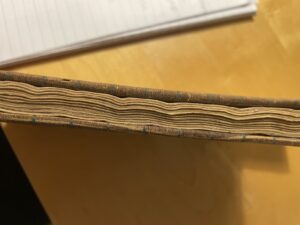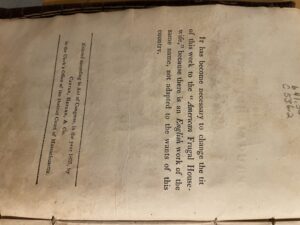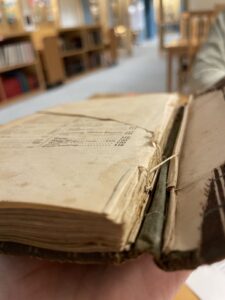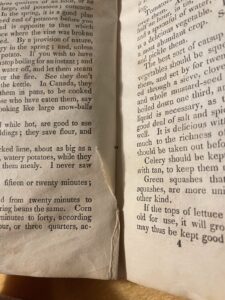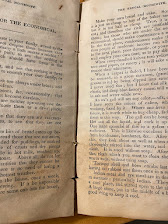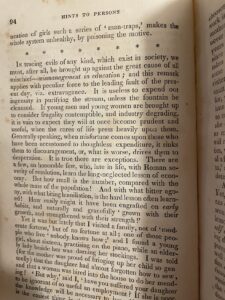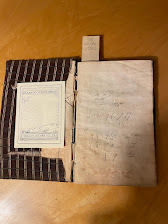The American Frugal Housewife by Lydia Maria Child was originally published in 1829 and within the span of a decade had thirty-five editions (“The Frugal Housewife,” 1). My focus is on the twentieth edition, but I examined the fourth edition too, which will be referenced to compare the two editions. The fourth and twentieth editions did not have many noticeable variations within the text itself. There was the addition of a copyright (Figure 1) to differentiate the work from a similarly named text in England. This addition of copyright occurred sometime between the twelfth edition and the twentieth edition.
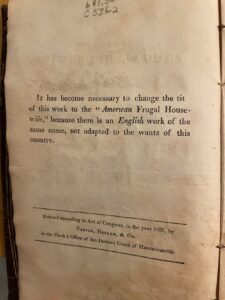
Figure 1
Through comparing arbitrary pages between both editions, no differences in the existing shared texts were discovered aside from slight formatting differences. However, the later editions included extra sections of chapters (Figure 2), noted at the beginning of the fourth edition.

Figure 2
There is no evidence that the twentieth edition was dismembered in any way for the purpose of sharing or selling pieces individually. Certain sections or recipes may have been cut out of other copies, as this book was popular throughout the 1830s, it is likely some readers could have shared the book or sections of it with others (Edwards, 243). If anything, there are additions to this book from previous owners. There are marginalia throughout the fourth edition I examined. I think the notes are related to a recipe’s cost or conversion of measurements, and there is also a lengthy note at the beginning of the book. The notation is about the reader’s preferences for specific recipes, such as one note expanding on preparing sausages. With the letter being at the beginning of the book, it is likely the reader has read the book at least once before and referred to it periodically for recipe ideas. Based on the marginalia, the previous owner of the book preferred easy recipes and side dishes, like sausage. There are also drawings on the back inside cover of the book in both pen and pencil.

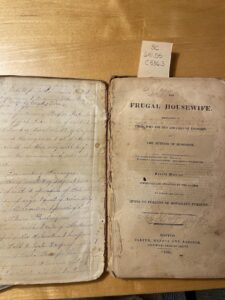
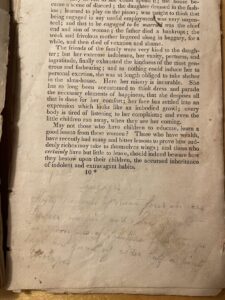

Figures 3 and 4
The twentieth edition is complete with a homemade cover and stitching, an attempt to personalize the book, which suggests its common use in everyday life. The patterned fabric is glued onto the boards of the book and there is loose, guitar string-like, stitching holding the cloth together at its ends. The handmade cover alludes to the sentimental value of this book; its previous owner carefully stitched and designed a handmade cover to decorate and elevate the cookbook, which implies that it was coveted.
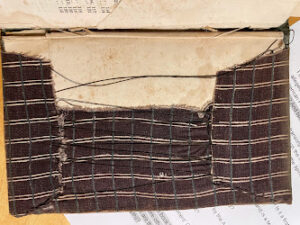
Figure 5
While I could not find the original cost of The American Frugal Housewife, I assume copies of the book were sold at a reasonable price, affordable to those wanting to think more economically. A low cost could also be assumed from the popularity of the book and its thirty-five editions. The editions I examined are not particularly rare or priceless as this book was reprinted a considerable amount. There are many copies of both books circulating, therefore the book is not comparatively valuable, especially the latter editions. When I looked online for copies for sale, I found that most listings of the book are inexpensive and for recently published editions. Reprintings from 1989 can be purchased on Amazon for about fifteen dollars. There is also a paperback edition published in 2017 available for under five dollars. It is interesting to note that the version being sold is the twelfth edition. (“The American Frugal Housewife: Dedicated to Those Who Are Not Ashamed of Economy,” 1). I wonder why that one has modern popularity. However, two websites list twentieth (CHILD, 1) and twenty-seventh editions (CHILD, Mrs. [Lydia Maria], 1) being sold for $116 and $275, respectively.
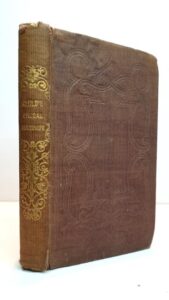
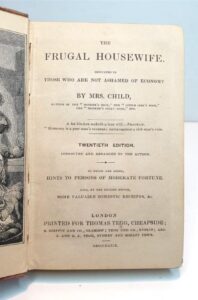
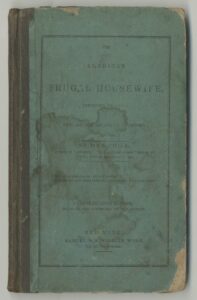
Figures 6 and 7
Dickinson College received this book as a donation from Charles Coleman Sellers, former Librarian of the College (“Charles Coleman Sellers,” 1). The date and year Sellers donated the twentieth edition are unknown, as he gifted the college numerous books over the years. After his death, he left several books to the College but the accounts from his estate do not list specific titles. Due to this uncertainty, there is not much known about how Sellers acquired the book; if it was passed down within his family or as an arbitrary acquisition. There are notes in the front matter of the book which look like dates. This might suggest the book was passed down and the dates are representative of when someone owned it, however, the dates are in the same handwriting so they could also be from a bookseller.
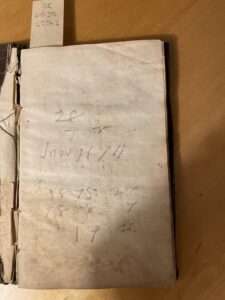
Figure 8
As this is a recipe and home economics book, meant to be utilized by its reader in the home, it could have been passed down through the family or shared with other friends and relatives. The fourth edition contains significant marginalia and an insert in the front matter with notes on the book’s contents, which could also suggest that it was passed down from generation to generation. However, I cannot confirm this as the records of Sellers’ donations do not contain exact dates and relevant information about each text.
Prior to research, while I considered if this book were banned, I thought of Lydia Maria Child’s other published works, notably those commenting on gender and race, and wondered if their reception would influence this book. I had originally thought that because of the progressive nature of her previously published works, there could be a target on this book, leading to it being scrutinized and potentially, in an extreme case, banned. It was interesting, but also not surprising, to find that The American Frugal Housewife was never banned as it was received well and rose to popularity among women. Lydia Maria Child published this book as her husband had accumulated a lot of financial debt, which led Child to consider economic solutions for a household. While she was outspoken about abolition and Women’s Rights, publishing works such as “An Appeal in Favor of Americans Called Africans” and “The History of the Condition of Women, in Various Nations and Ages,” the popularity of her guidebook did not seem to wane. It became a staple in American households, securing a spot in an unexplored market of American books geared towards women (Rushing, 1).
To evolve with the modern age of technology, this book has been digitalized a few times, most notably by the Library of Congress, which has a first edition available to view digitally (“The Frugal Housewife: Dedicated to Those Who Are Not Ashamed of Economy,” 1). In the context of today, some of the information in the book is obsolete, especially some of the phrasing used in the book. However, most of the book is an instructional guide for preparing economical dishes, and many sections focus on preparing and harvesting various foods. While some of the recipes are not as common today, like bird’s nest pudding, the book does provide instructions and tips on creating various dishes with straightforward language that someone could easily follow today.
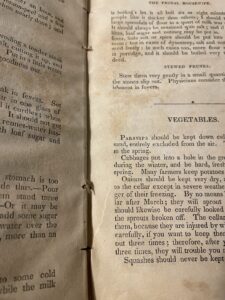
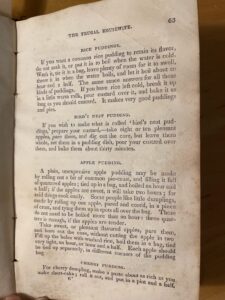
Figures 9 and 10
Works Cited
“Charles Coleman Sellers (1903-1980).” Charles Coleman Sellers (1903-1980) | Dickinson College, Dickinson Colege , 2005, https://archives.dickinson.edu/people/charles-coleman-sellers-1903-1980.
CHILD, Mrs. “Abebooks.” By CHILD, Mrs. | Librera Antonio Castro, London: Thomas Tegg, 1839., https://www.abebooks.com/servlet/BookDetailsPL?bi=781698701&ref_=ps_ggl_17738760402&cm_mmc=ggl-_-COM_Shopp_Rare-_-product_id&gclid=Cj0KCQjwiZqhBhCJARIsACHHEH8PQEGaqw4WHfhEQO0w1QbahFbWU57nLloKiALan-T4gwRxRdli6ecaAlwWEALw_wcB.
CHILD, Mrs. [Lydia Maria]. “Abebooks.” By CHILD, Mrs. [Lydia Maria]: Good Hardcover (1844) | Between the Covers-Rare Books, Inc. ABAA, Samuel S. & William Wood, New York, 1 Jan. 1970, https://www.abebooks.com/servlet/BookDetailsPL?bi=31113655462&ref_=ps_ggl_17738760402&cm_mmc=ggl-_-COM_Shopp_Rare-_-product_id&gclid=Cj0KCQjwiZqhBhCJARIsACHHEH-4LwG06CI1S0gr6z2VK_uoQxAWY4u2YXBAva0rYuid6cHwr0NQFR8aAltDEALw_wcB.
Edwards, Herbert. “Lydia M. Child’s the Frugal Housewife.” The New England Quarterly, Inc. , vol. 26, no. 2, June 1935, pp. 243–249., https://doi.org/https://www.jstor.org/stable/362453.
“The American Frugal Housewife: Dedicated to Those Who Are Not Ashamed of Economy.” Amazon, Samuel S. & William Wood, https://www.amazon.com/American-Frugal-Housewife-Dedicated-Ashamed/dp/0918222982/ref=tmm_hrd_swatch_0?_encoding=UTF8&qid=&sr=.
“The Frugal Housewife : Dedicated to Those Who Are Not Ashamed of Economy.” The Library of Congress, Library of Congress, https://loc.gov/item/43019104/.
“The Frugal Housewife.” Book by Lydia Maria Child | Official Publisher Page | Simon & Schuster, Simon & Schuster, https://www.simonandschuster.com/books/The-Frugal-Housewife/Lydia-Maria-Child/9781449431709#:~:text=It%20had%20over%2035%20printings,and%20economy%20in%20the%20kitchen.
Rushing, Erin. “Lydia Maria Child: Home Economy and Human Rights.” Smithsonian Libraries and Archives / Unbound, Smithsonian , 21 Dec. 2020, https://blog.library.si.edu/blog/2020/12/21/lydia-maria-child-home-economy-and-human-rights/#.ZCcai-zMKrM.
